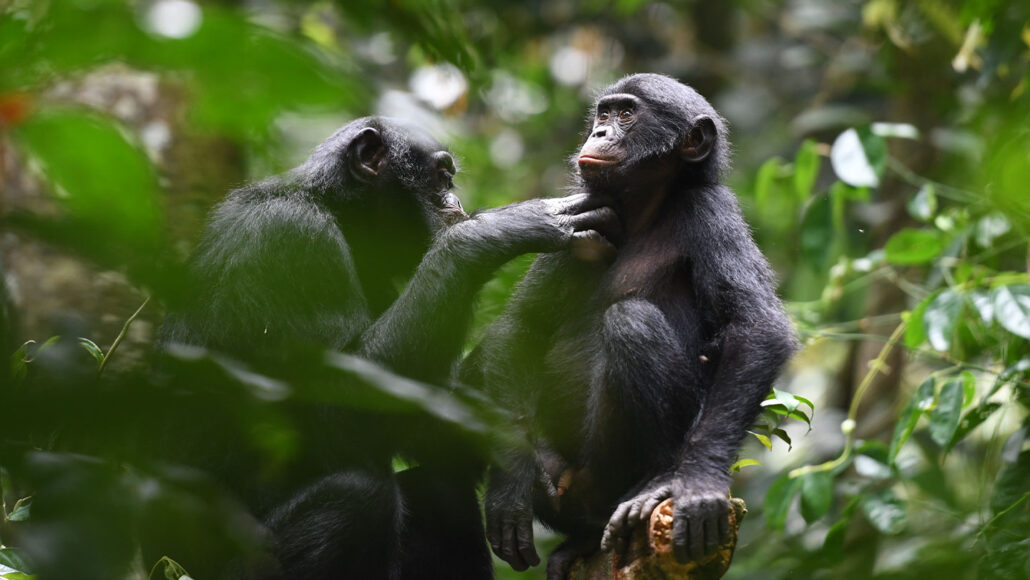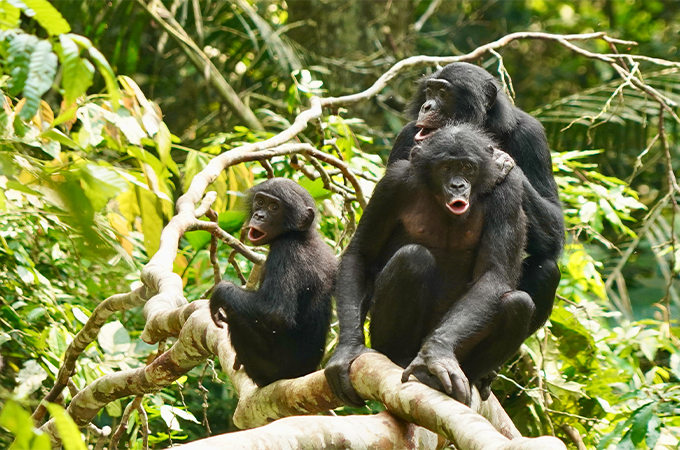Bonobos cooperate across social groups — even with no clear payoff
Such generosity to outsiders could provide insights into how human societies have evolved

Grooming is one form of cooperative behavior among bonobos. This adult female (left) is grooming a young male from a different social group in the Congo’s Kokolopori Bonobo Reserve.
M. Surbeck/Kokolopori Bonobo Research Project
By Jake Buehler
People of all ages cooperate and share resources with others. Often they extend this generosity even to people they may not know or where they get no obvious reward for it. Such interactions have been considered unique to humans. But some bonobos appear to share this same social behavior, new research finds.
Cooperation across social groups is thought to be central to human societies. So bonobos cooperating across group boundaries may help explain how large human societies evolved.
Bonobos (Pan paniscus) live in social groups where members may not be close relatives. They also tend to be tolerant of outsiders. It’s not unusual for them to groom and share food with members of outside groups. They have even been known to adopt others’ offspring. But the full picture of their cooperative behavior had been unclear.

Liran Samuni and Martin Surbeck wanted to dig deeper into this behavior. Samuni is a behavioral ecologist at the German Primate Center in Göttingen. Surbeck is a behavioral ecologist at Harvard University in Cambridge, Mass. They chose to work in the Congo’s Kokolopori Bonobo Reserve. For two years, they recorded the interactions of two groups of these primates.
The team documented which bonobos groomed or shared food with others, and when. The animals didn’t always get along, though. Conflict and competition would sometimes crop up between social groups. The researchers recorded instances when the bonobos formed alliances to attack another member.
Extensive interactions
Encounters between the two bonobo groups happened a lot. They interacted nearly 100 times. The groups spent one-fifth of their time in each other’s company during the two years they were studied. Some meetings lasted only an hour. Others went on for weeks.
During these meetups, the researchers saw lots of cooperation. They documented more than 3,700 instances of grooming. One in every 10 instances involved bonobos from different social groups. And about one-sixth of the alliances (16 percent) that formed to attack another bonobo were between animals from different social groups.
In addition, six percent of all shared food was between the groups. Clearly, Samuni says, “This is not a one-off kind of thing.”
The bonobos’ cooperation also wasn’t random. Those that cooperated in their own group were more likely to interact with like-minded members of the other group. And payback wasn’t the motivating factor, the researchers say. Only one in every seven animals who shared food with the other group saw this favor returned.
Samuni and Surbeck described their findings November 16 in Science.
Similar things have been seen among captive bonobos. This suggests that their generosity to outsiders is innate. Cooperating with relatives is one way of ensuring that one’s own genes survive. Helping outsiders is a more indirect way of doing the same thing.
Similar but different
More than bonobos and humans are known to cooperate. Male dolphins will join with unrelated males to guard females during mating. Unlike the bonobos, however, the dolphins did see a benefit from their actions. It could up a guy’s chance of fathering a child.
Food sharing is rare between unrelated members in other species, Samuni says. Vampire bats, bonobos and humans do this. Chimpanzees share food, Surbeck says — but only within their social group. Sharing among people “is considered one of those behaviors that supported our societies, that allowed us to sustain each other in terms of food shortfalls,” Samuni says.
That behavior in people is what makes the new findings so interesting, says Shinya Yamamoto. He’s a comparative psychologist at Kyoto University in Japan.
“Humans sometimes compete or fight with neighboring groups,” Yamamoto says. Other times, he notes, we’ll cooperate even with outsiders. It’s easier to find examples of aggression and competition among our primate relatives. That’s especially true of our close relatives, the chimpanzees. But how our cooperative behavior came about is still not clear.
“Under which circumstances do you see this cooperation? Under which circumstances do you see more of a chimpanzee pattern — in permanently hostile relationships between groups?” Surbeck asks. “What shifts the needle from one to the other?”
A cultural component?
The new study hints that cooperating with outsiders doesn’t rely on cultural factors and social norms. These influences are considered critical to such cooperation in humans, Samuni says.
“We are showing quite a simple system,” she says. “And we still see it emerging, and in a way that is quite similar [to that in us].”
It’s possible that some bonobos have learned over generations to be more social, Yamamoto says. That’s essentially how elements of our culture formed. More bonobo studies might reveal something much like this.







